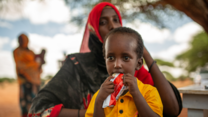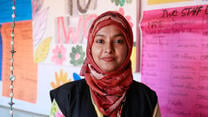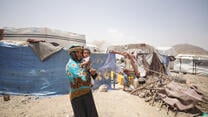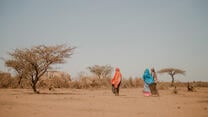NGOs warn of looming food crisis
- The World Food Program (WFP) has announced a "pause" in the General Food Assistance (GFA) program in Yemen, impacting 9.5 million people facing food insecurity in northern Yemen.
- The suspension will worsen the already critical humanitarian situation, disproportionately affecting vulnerable populations like children, pregnant women, and the elderly.
- Yemen is facing a severe crisis, with 17 million people at crisis and emergency levels of food insecurity, including 2.2 million malnourished children. An estimated 6.1 million people are on the brink of famine.
Country facts
- Population: 33.7 million
- People internally displaced by crisis: 4.5 million
- Rank in Human Development Index: 183 of 191
IRC response
- Started work in Yemen: 2012
Humanitarian needs in Yemen remain elevated due to protracted conflict, economic crisis and displacement. The IRC provides essential services, such as health, nutrition, water, livelihood and protection programs.
Yemen has been embroiled in protracted violence since 2014, ignited by failed negotiations between Ansar Allah and the Internationally Recognized Government, which triggered conflict and set the stage for one of the world’s most severe humanitarian crises.
The conflict has resulted in over 377,000 deaths, with nearly 60 percent of fatalities attributed to indirect causes such as food insecurity and lack of access to health services. Violations of international humanitarian law, including targeted and indiscriminate attacks against civilians and civilian infrastructure, have been committed by all parties involved.
A decade of conflict has devastated the country’s economy, leading to soaring inflation and widespread poverty. Many Yemenis struggle to afford basic necessities, including food. The economic downturn has caused high levels of unemployment and poverty, with hundreds of businesses disrupted or destroyed, depriving many of livelihood opportunities.
Humanitarian needs in Yemen have reached critical levels due to the breakdown of basic services, prolonged displacement and the collapse of the country’s economy. Climate shocks, such as droughts and floods, are significant factors driving displacement and exacerbating these needs. Over two-thirds of the population—21.6 million people—are in urgent need of humanitarian assistance.
Yemen’s healthcare system is on the brink of collapse, with over half of all health facilities either closed or operating at reduced capacity. Many hospitals have sustained damage during the decade-long conflict, and a widespread shortage of essential medicines and qualified personnel has severely limited civilians' access to medical care.
Levels of malnutrition and food insecurity in Yemen are among the highest globally. Approximately 1.3 million pregnant or breastfeeding women and 2.2 million children under the age of five require treatment for acute malnutrition. Preventable diseases such as cholera and pneumonia have contributed to a rise in child mortality rates.
The conflict has exacerbated protection risks, including harmful labor, violence, exploitation and abuse for all Yemenis. However, women, children and people with disabilities face the greatest risks. Existing child protection systems are inadequate in addressing the specific needs of vulnerable children, including those separated from their families. An estimated 17.7 million people in Yemen are in need of protection services.
While the IRC and the wider humanitarian community continue to deliver assistance to those in need, insufficient funding and access challenges continue to hamper the response in Yemen.
Find out more in the IRC's 2024 Emergency Watchlist.
The IRC’s mission is to help people whose lives and livelihoods are shattered by conflict and disaster to survive, recover and gain control of their future.
The IRC has been working in Yemen since 2012 and rapidly scaled our programming in 2015 to address escalating humanitarian crises sparked by conflict. While the ongoing violence and restrictions on humanitarian actors present operational challenges, the IRC’s 350-person staff and 650 paid volunteers in Yemen continue to support affected populations through the provision of critical healthcare, economic empowerment, women’s protection and empowerment and nutrition programming.
Donate: Make a tax-deductible donation to support the IRC. We are on the ground saving children and families from malnutrition and life-threatening diseases. Your gift will help us as we work to save lives in Yemen and in countries around the world.





